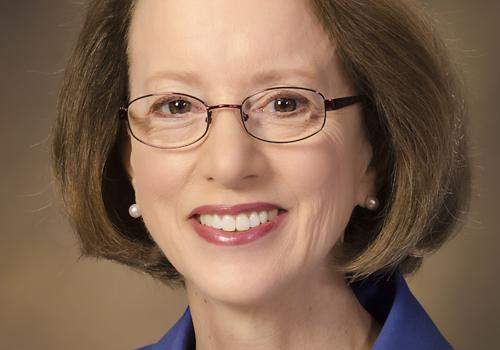Research shows that women and health professionals both have difficulty recognizing symptoms
of heart disease in women, which can lead to delayed treatment and incorrect diagnoses,
says UA nursing professor Anne Rosenfeld.
 Heart disease is the leading cause of death for both men and women in the United States, but a new scientific statement from the American Heart Association (AHA) is the first to document how women experience the disease differently.
Heart disease is the leading cause of death for both men and women in the United States, but a new scientific statement from the American Heart Association (AHA) is the first to document how women experience the disease differently.
 Anne G. Rosenfeld, PhD, RN, FAHA, FAAN, professor and cardiovascular nurse-scientist at the University of Arizona College of Nursing, is vice chair of the AHA writing group that recently published the statement, titled “Preventing and Experiencing Ischemic Heart Disease as a Woman: State of the Science.”
Anne G. Rosenfeld, PhD, RN, FAHA, FAAN, professor and cardiovascular nurse-scientist at the University of Arizona College of Nursing, is vice chair of the AHA writing group that recently published the statement, titled “Preventing and Experiencing Ischemic Heart Disease as a Woman: State of the Science.”
“Due to a number of factors, including lack of awareness, often women don’t recognize their symptoms as heart disease,” said Dr. Rosenfeld, also a member of the UA Sarver Heart Center. “As a result, women frequently delay seeking help, and when they do, they report difficulty receiving a correct diagnosis because health-care professionals also don’t recognize their symptoms as heart disease.”
Research has shown that women are less likely to experience chest pain than men, but most do experience symptoms such as shortness of breath or unusual fatigue for weeks, even months before a cardiac event. Additional symptoms can include discomfort in the jaw, teeth or arms, nausea, neck pain, dizziness and fainting.
Often women attribute their symptoms to non-cardiac reasons, minimize the importance of their symptoms or prioritize their family, work and social responsibilities ahead of seeking medical attention.
“If you have the sense that something is not right, you should call 911,” said Dr. Rosenfeld. “Don’t drive yourself. Don’t let someone else drive you. Studies show that even if you get to the hospital sooner than the ambulance, the person who comes in the ambulance will be seen sooner. That’s why you call 911.”
Because research has shown that health-care providers often overlook heart disease as the underlying cause of women’s symptoms, Dr. Rosenfeld says that how women communicate their symptoms once they arrive at the emergency room is critical.
“By and large women don’t say, ‘I have chest pain;’ they say ‘I have chest discomfort.’ However, if a clinician is listening for ‘pain’ and they hear ‘discomfort,’ they may not suspect heart disease initially,” said Dr. Rosenfeld. “Instead, women should say, ‘I think I’m having a heart attack. These are unlike symptoms I’ve had before.’”
Promoting awareness among minority women is particularly important. Black women have a higher prevalence rate (7.0 percent) compared to Hispanic women (5.9 percent) and white women (4.6 percent). However, compared to 65 percent of white women, only 36 percent of black women and 34 percent of Hispanic women are aware that heart disease is the leading cause of death for women.
Additionally, the death rate for younger women, ages 35-44, is continuing to increase while decreasing in their male counterparts. Considering 80 percent of heart disease is preventable, the authors of the statement stress that educating women about their risk factors should start as early as childhood.
To help raise awareness, Dr. Rosenfeld suggests women of all ages ask their health-care provider the following three questions at their next appointment.
- What is my risk for heart disease?
- I’ve been having these symptoms; what do they mean?
- How do I keep myself heart healthy at this stage in my life?
Future directions for clinical practice discussed in the AHA statement include increased education for both health-care providers and women on emerging risks for heart disease, and routine assessment of risk factors and ways to reduce risk as part of every clinic visit for women.
When asked about the role of nurses in raising awareness, Dr. Rosenfeld noted that the numerous interactions nurses have with women are opportunities to educate and empower.
“The triage nurse in the ER is the one listening for these symptoms when patients arrive,” said Dr. Rosenfeld. “Nurses care for women who have had a balloon or a stent placed in their heart or had bypass surgery. Nurse-midwives and nurse practitioners see women regularly in their earlier years. It’s important to seize every opportunity we have to educate women about prevention, risk and symptoms.”
Interested in learning more about your risk for heart disease? Take this Heart Disease Risk Assessment from the UA Sarver Heart Center.
About the University of Arizona College of Nursing
At the University of Arizona College of Nursing, faculty members envision, engage and innovate in education, research and practice to help people of all ages optimize health in the context of major life transitions, illnesses, injuries, symptoms and disabilities. Established in 1957, the college ranks among the top nursing programs in the United States. For more information, see: www.nursing.arizona.edu
About the University of Arizona Health Sciences
The University of Arizona Health Sciences is the statewide leader in biomedical research and health professions training. The UA Health Sciences includes the UA Colleges of Medicine (Phoenix and Tucson), Nursing, Pharmacy and Mel and Enid Zuckerman College of Public Health, with main campus locations in Tucson and the growing Phoenix Biomedical Campus in downtown Phoenix. From these vantage points, the UA Health Sciences reaches across the state of Arizona and the greater Southwest to provide cutting-edge health education, research, patient care and community outreach services. A major economic engine, the UA Health Sciences employs almost 5,000 people, has nearly 1,000 faculty members and garners more than $126 million in research grants and contracts annually. For more information: http://uahs.arizona.edu
ALSO SEE:
"Women Experience Heart Disease Differently from Men" (UANews) | Posted May 9, 2016
Media Contact: Janelle Drumwright


